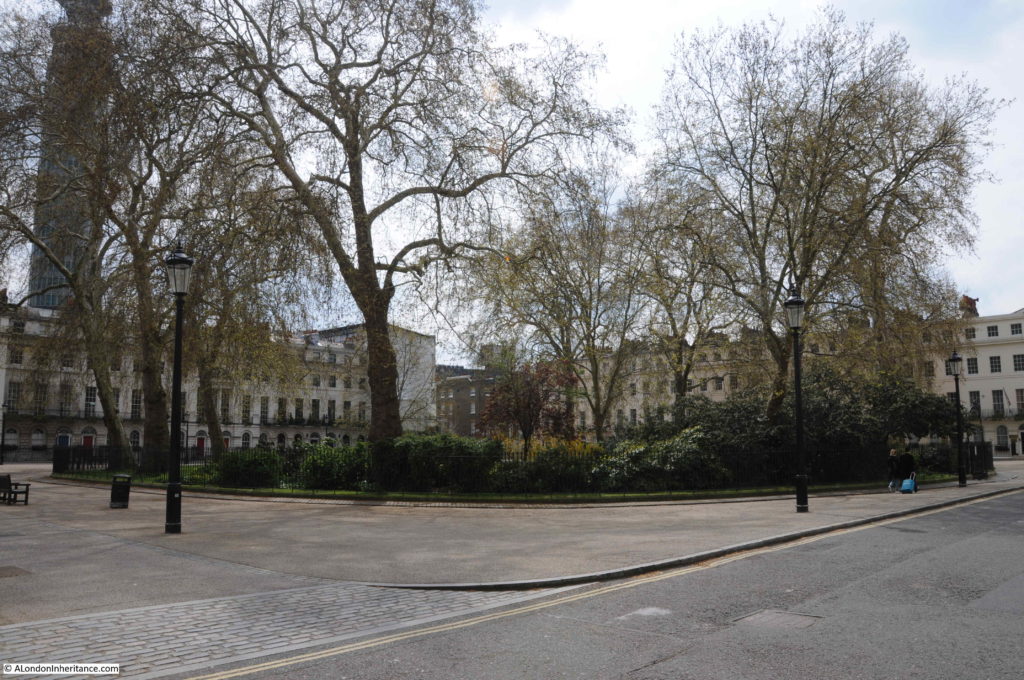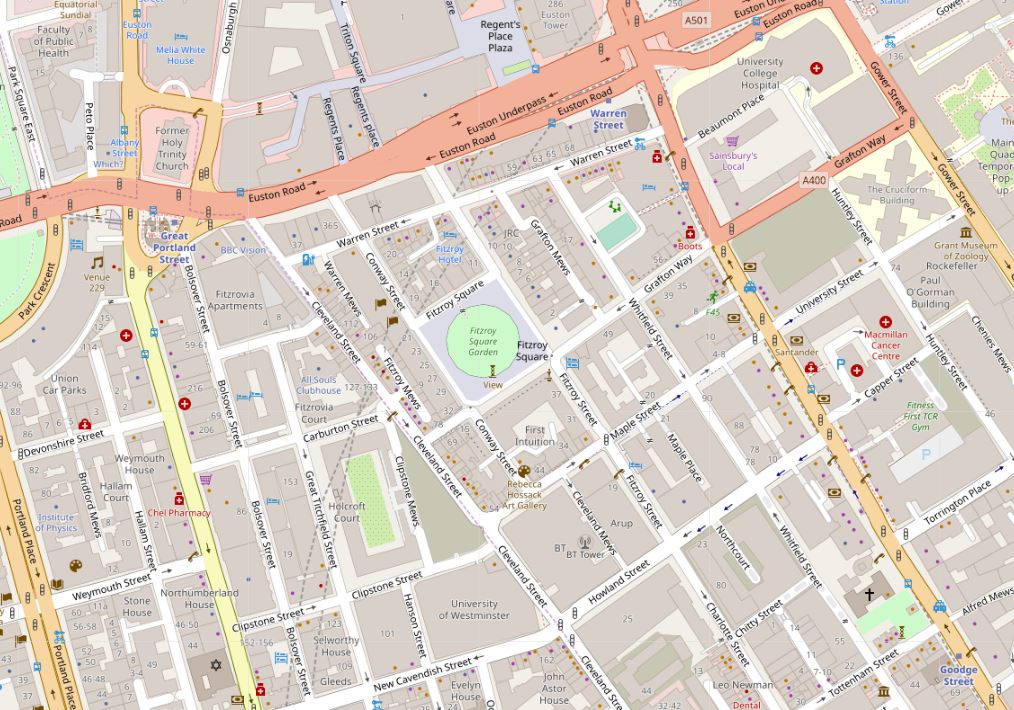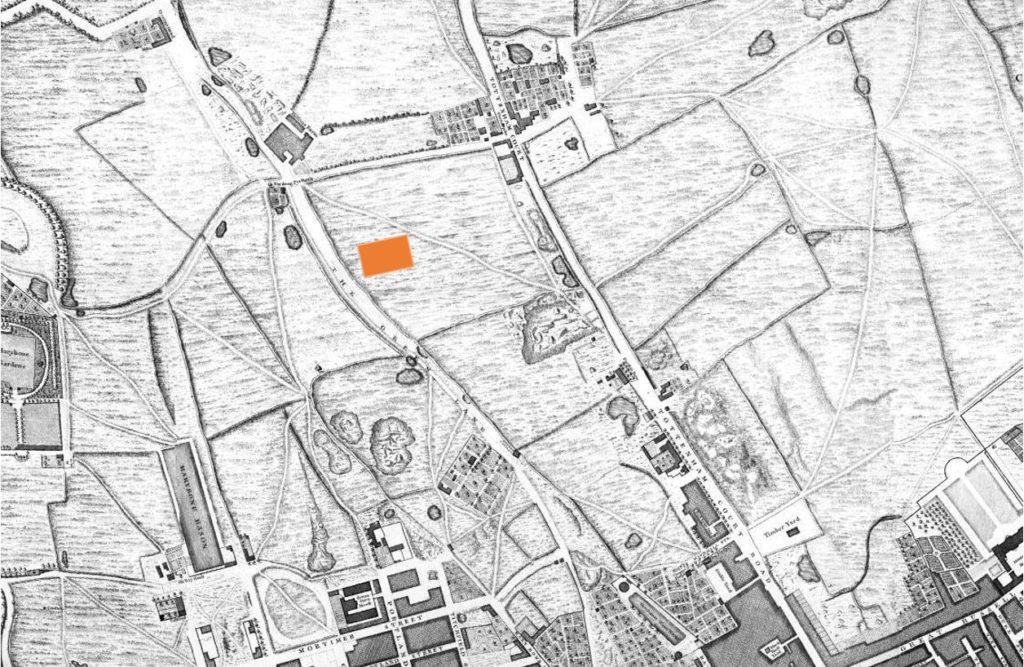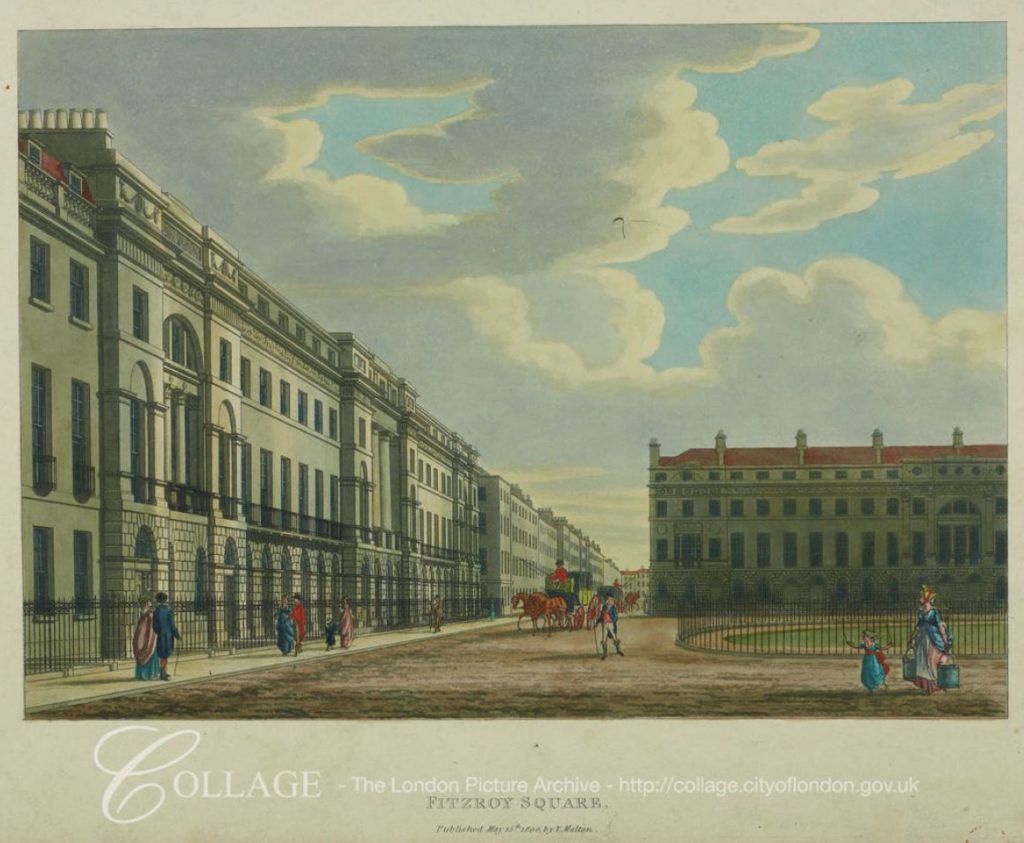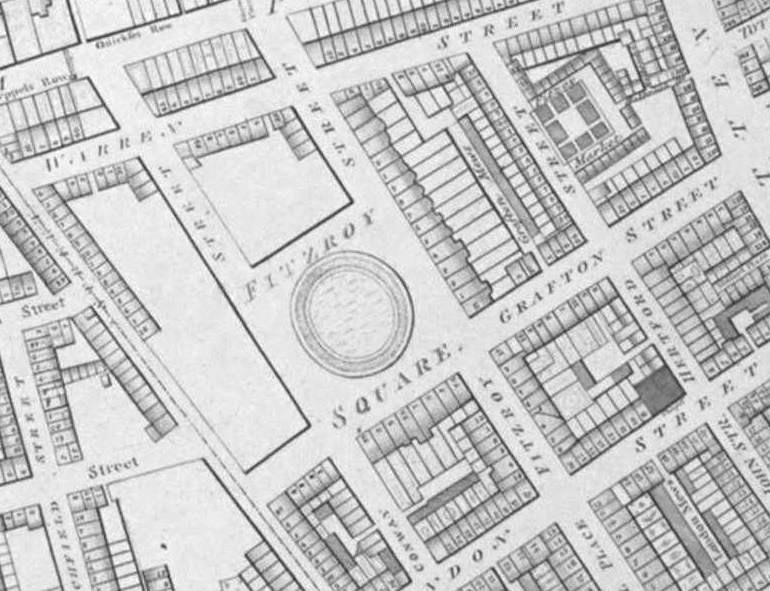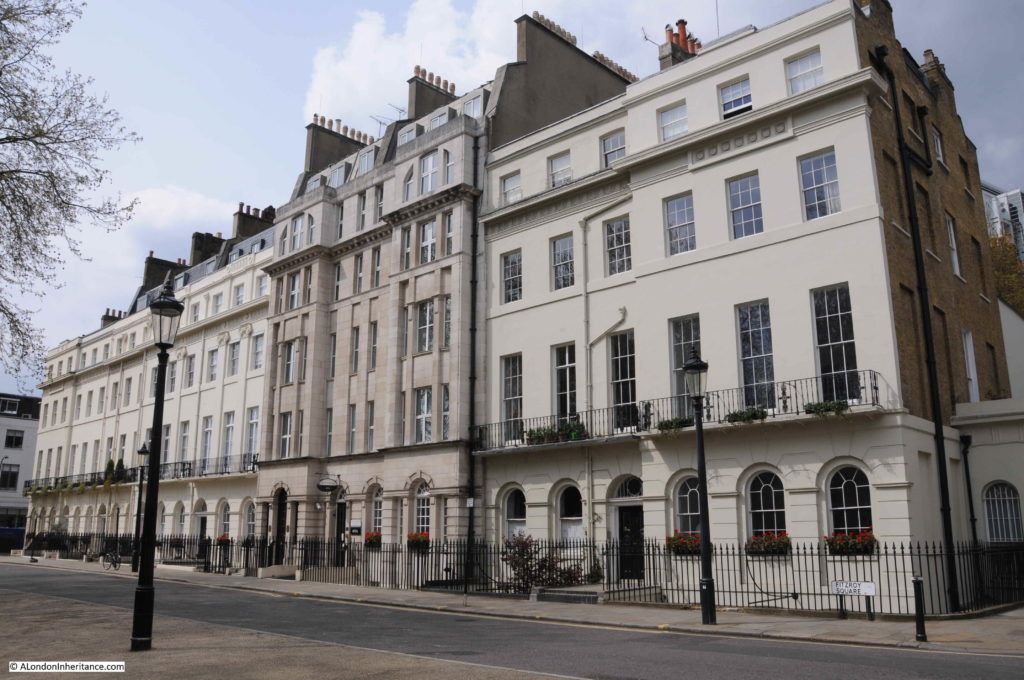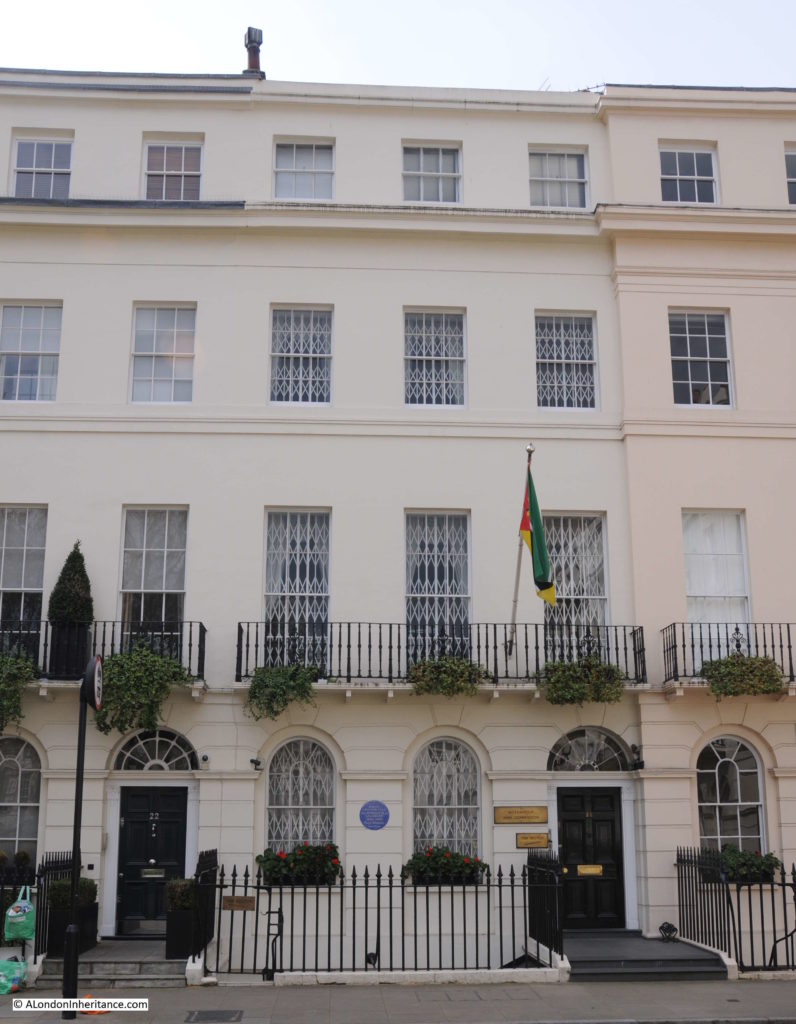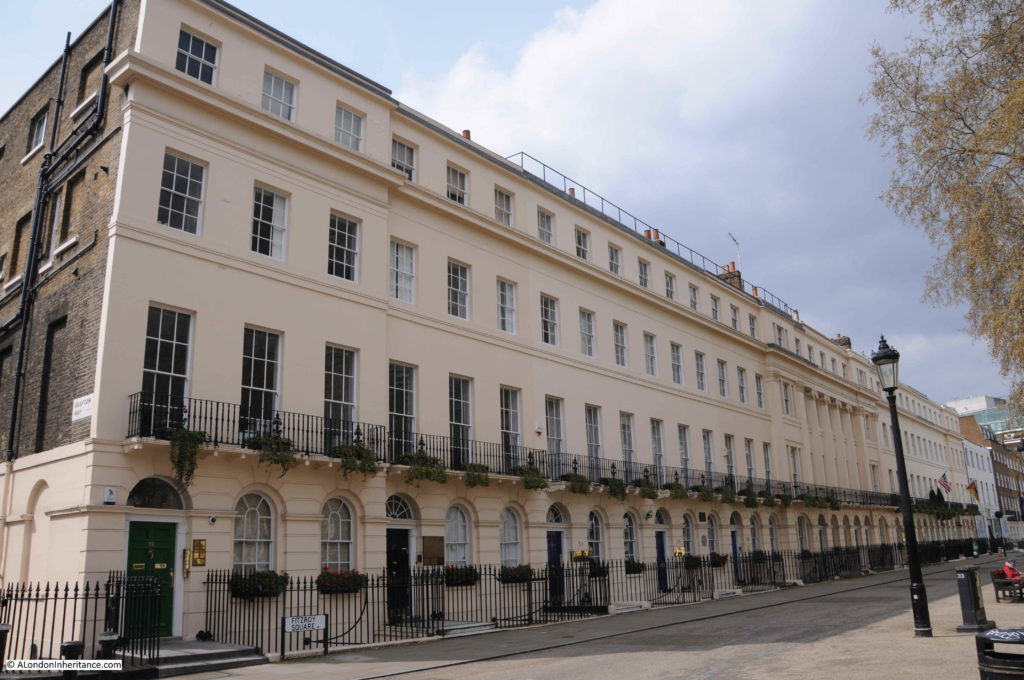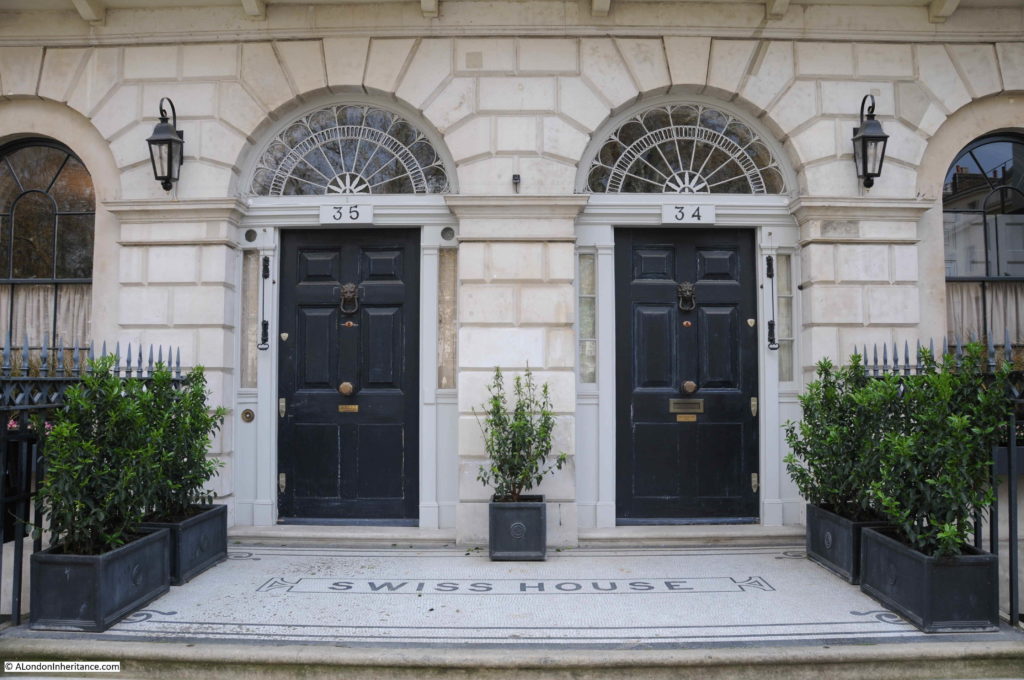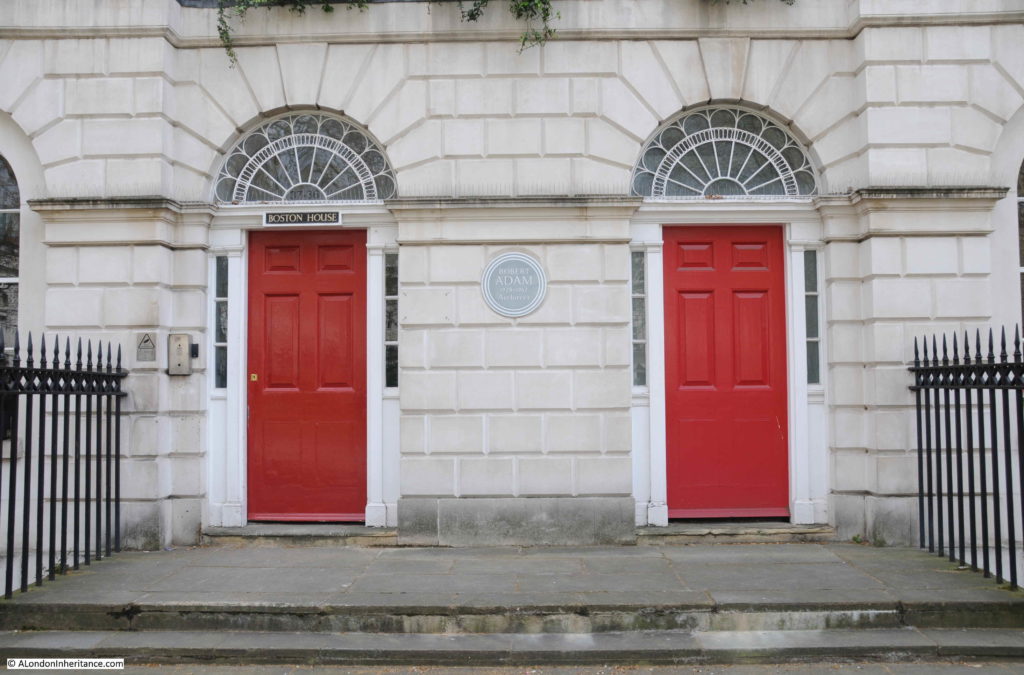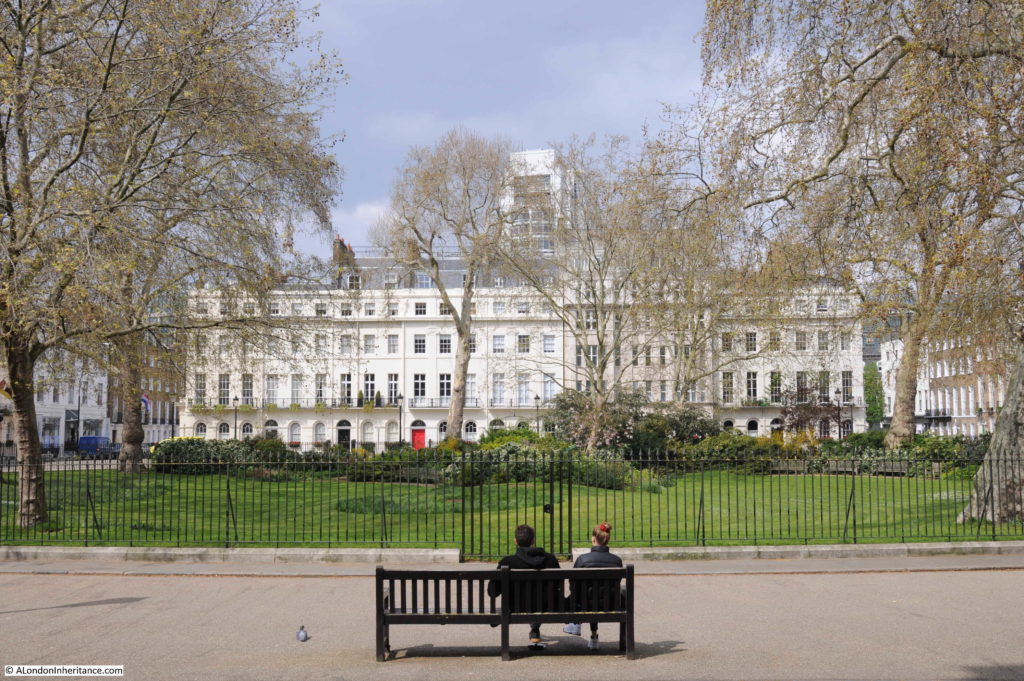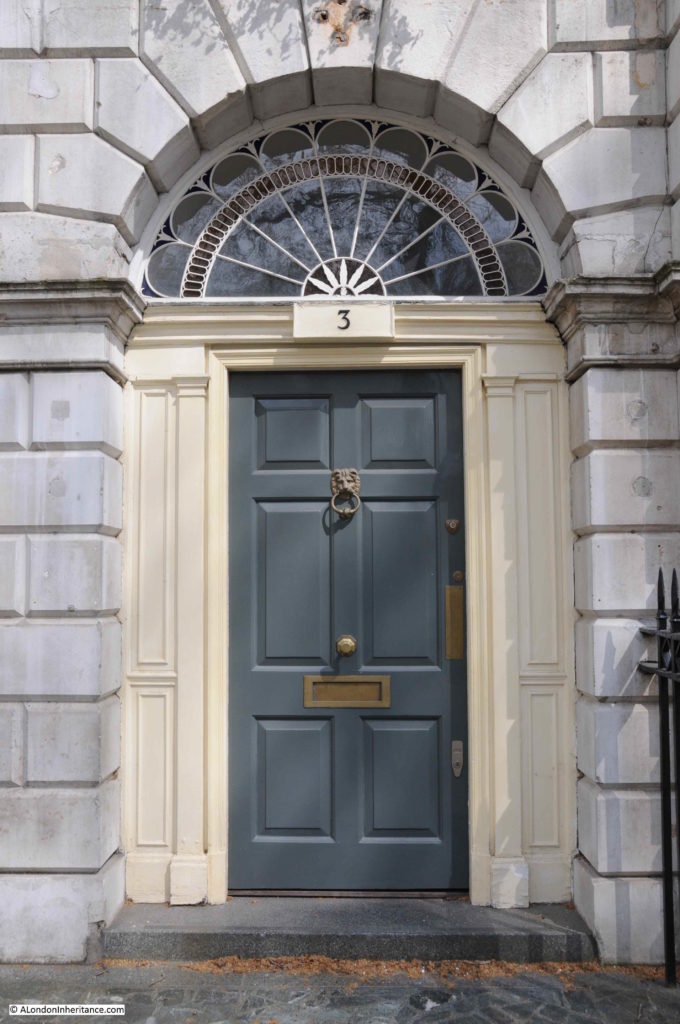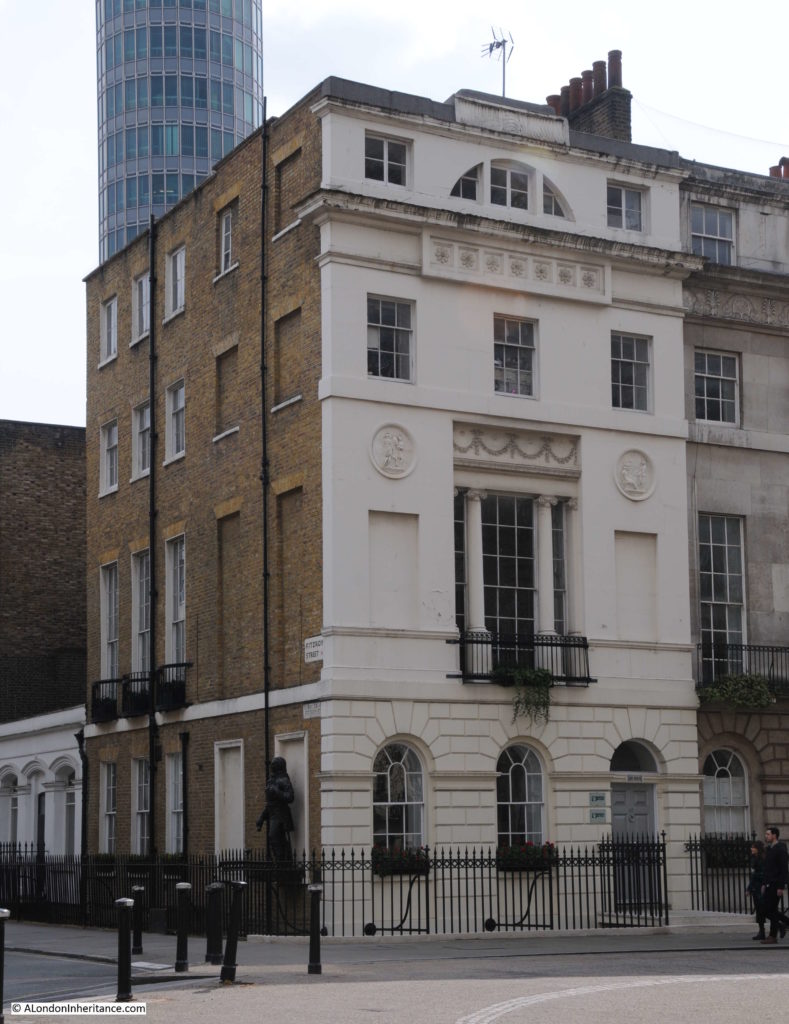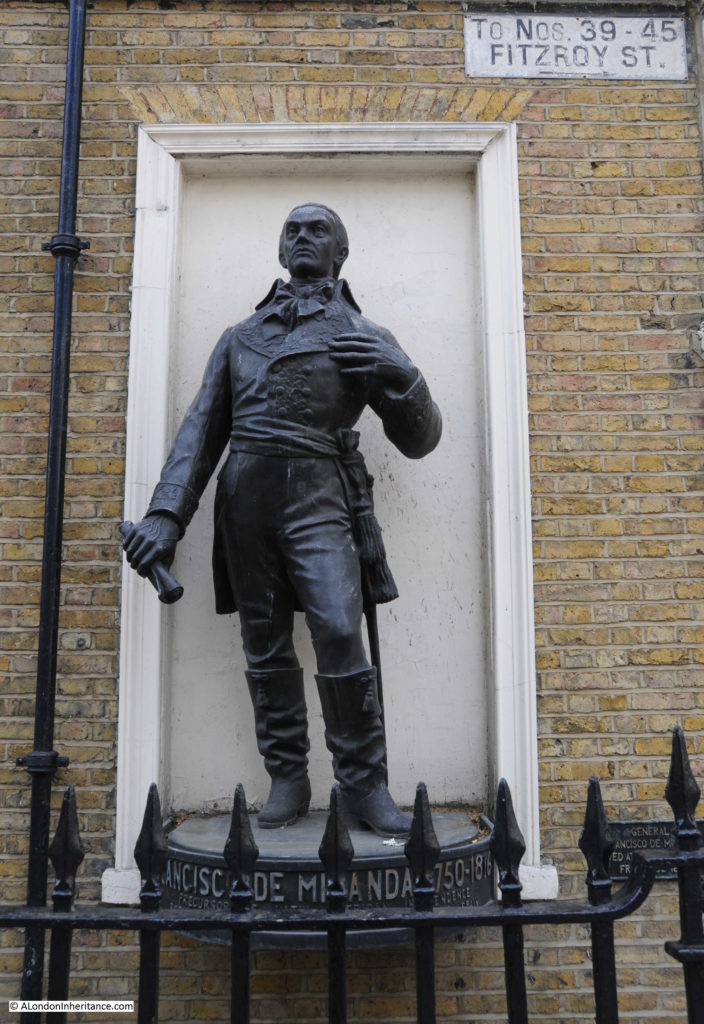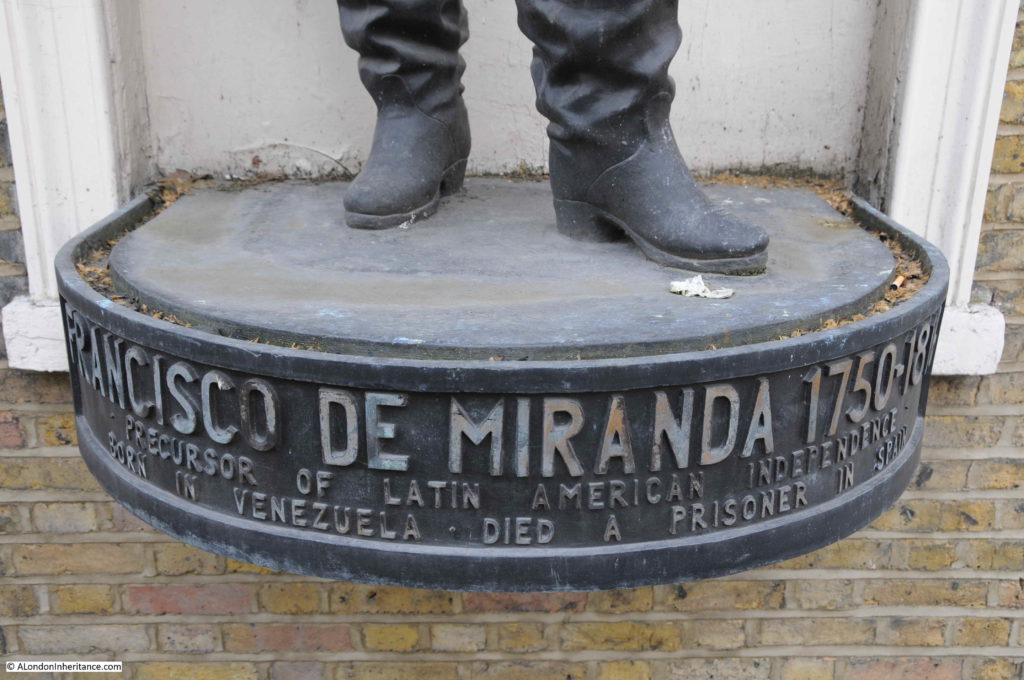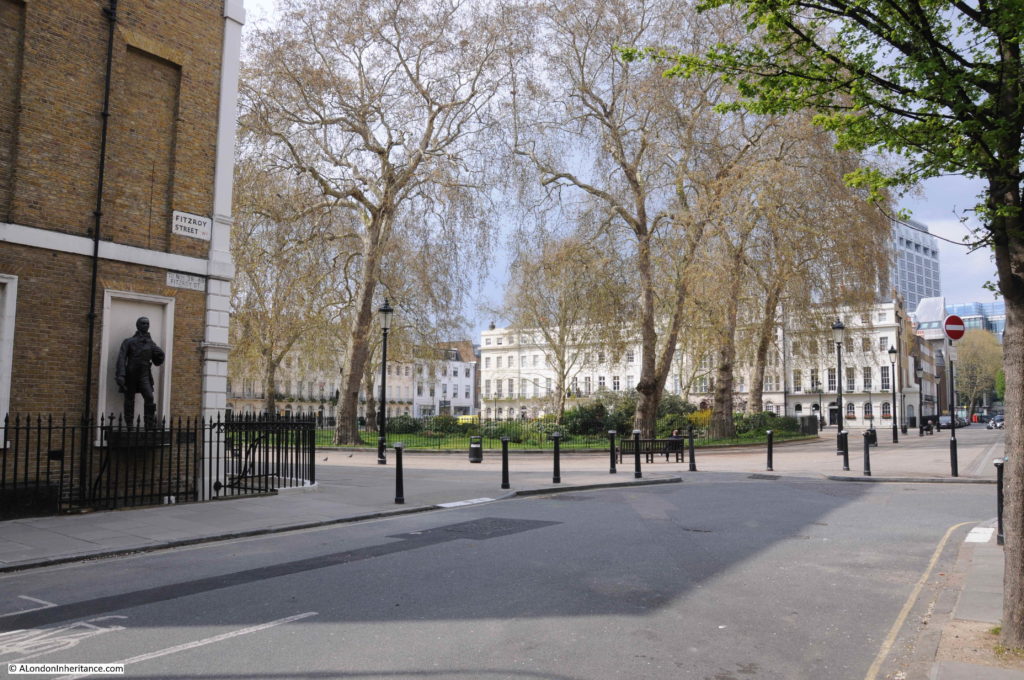A few months ago, I wrote a post about the J.Evans Dairy in Warren Street. After walking along Warren Street I headed south along Fitzroy Street to have a look at Fitzroy Square, one of the many squares and gardens built as London expanded north and west during the 18th and early 19th centuries.
It was the weekend, so was quiet during my visit, but it was strange walking from the traffic of the Euston Road, to a peaceful square and the sound of birdsong.
Fitzroy Square is south of Warren Street and Euston Road and to the west of Tottenham Court Road.
A large square with a central, circular garden. In the following map extract, Fitzroy Square can be seen in the centre (© OpenStreetMap contributors):
Fitzroy Square was developed by Charles Fitzroy, the 1st Baron Southampton in the 1790s, when the east and south sides of the square were built. The northern and western sides to the square were added between 1825 and 1835.
The amount of building in this part of London during the later half of the 18th century and early 19th century must have been considerable.
John Rocque’s map of 1746 still shows the area as rural, consisting of large fields, some roads and tracks across the fields.
The following extract from Rocque’s map shows the area. I have highlighted the approximate location of Fitzroy Square with the orange rectangle.
Tottenham Court Road is the road towards the right side of the map, running from top to bottom. The cluster of buildings towards the top of Tottenham Court Road is where the future junction with Euston Road would be located.
The following photo is from where Fitzroy Street joins Fitzroy Square. The two built sides of the square (eastern on the left and southern in the distance), were the first parts of the square to be developed, both to designs by the Adams brothers however the southern side of the street was very badly damaged during the last war and has since been rebuilt.
The London Metropolitan Archives, Collage collection has a very similar view of the square to my photo above. The print below is dated 1800 and shows the square looking much the same as it does today, with the exception of the trees and plants in the central garden which originally appeared to be empty space.
Image credit: London Metropolitan Archives, City of London: catalogue ref: SC_PZ_SP_02_122
Residents of city squares often wanted the central space kept free as there was concern about who could be hiding in the planting (worries about robbery and theft) , or that planting the central square would take away from the grandeur of the surrounding houses.
There is a newspaper report from October 1795 which states that “A new market for the sale of meat, vegetables &c. was on Saturday opened on Lord Southampton’s estate in the neighbourhood of Fitzroy Square”. Perhaps this is what the centre of the square was used for, however I would be surprised if such a market was allowed in the centre of the square as it would probably have had an impact on the perception of the square and the value of the properties.
Rather appropriately, the conservation body, the Georgian Group have their head office in one of the buildings along the eastern side of the square.
Horwood’s map of London from 1799 confirms that the southern and eastern sides of the square were developed first, with the northern and western sides developed later in the 19th century.
Compare Horwood’s map of 1799 with Rocque’s map of 1746 and it shows how much building there had been in the 50 years between the two maps.
The street leading off Fitzroy Square from the south-east corner was Grafton Street, but is now Grafton Way, possibly renamed to avoid confusion with a Grafton Street that had already been built.
This is the northern side of Fitzroy Square, which was built between 1827 and 1828:
There are a number of Blue Plaques across the square. On the building that houses the Mozambique High Commission, along the western side of the square, is a plaque recording that Robert Gascoyne Cecil, 3rd Marquess of Salisbury lived in the building. He was prime Minister for various periods between 1885 and 1902.
Further along the western side of the square are two plaques on the same building that record George Bernard Shaw and Virginia Woolf living in the building (although not at the same time).
View across the square from the south-western corner. When the trees are in full leaf they will obscure the new towers that hover behind Fitzroy Square and it is possible to imagine the square as it would have looked soon after completion.
The gardens in the centre of the square are privately owned, belonging to those who own the freehold of the buildings that surround the square. The gardens are occasionally open during the Open Garden Squares Weekend.
The sculpture in the gardens, to the right of the above photo is titled ‘View’ and is by Naomi Blake. It was installed to commemorate the Queen’s Silver Jubilee in 1977
The southern edge of the square was badly damaged by wartime bombing and a high explosive bomb fell on the north-west corner.
As with many open spaces in London during the war, it was used for temporary water storage, to be used in the event of fires, as bombing frequently reduced the supply and pressure of water from the underground pipes. A strange and tragic death was recorded in the Daily Mirror on the 4th July 1942 highlighting the dangers of these water storage installations:
“Nap – It Led To His Death: Giving evidence at a St. Pancras inquest yesterday on Frank Edgar Husson, 51, of Stanhope-street, St. Pancras, who was drowned in an emergency water dam in Fitzroy-square, Dr. jean Mary White suggested that Husson might have fallen asleep while seated on a girder and slipped into the water.
It was stated that Husson, a builder’s labourer, walked across a girder, and as he had ten minutes before resuming work after lunch, he might have sat on a girder. No splash was heard. A verdict of accidental death was recorded.”
During the war, The Sunday Mirror had a regular feature where men in the services would write in regarding someone they briefly met, and wanted to meet again. The Sunday Mirror promised that “We print each letter in the hope that the girl will recognise herself and, if she cares to, will write. We have the full names and addresses of each man.”
Fitzroy Square featured in one letter on the 30th March 1941 from a Corporal R. Stephens of the Coldstream Guards:
“During a London blitz I was walking in Fitzroy-square when a bomb hit a nearby building, and my friend and I made for a rush for the wreckage where a number of girls were sheltering in a basement. By this time the A.R.P. men were well on the job, and all the girls, with the exception of two, were escorted to nearby houses for shelter.
The two left behind accompanied my friend and I to a public shelter, having to fling ourselves flat several times while bombs fell perilously close.
I admired those two girls for their bravery, and one in particular fascinated me so much that I felt that I did not want to leave her.
But I was obliged to leave, without even plucking up enough courage to make a date with her, as I had to be back in barracks at midnight.
I am hoping though, that she will recognise herself, and will write to me.”
It is this sort of human detail that I find fascinating – so many millions of individual stories of those who have been in London over the centuries. I wonder if Corporal R. Stephens ever did find the girl he met in Fitzroy Square?
The western terrace of houses, dating from 1832 to 1835:
On the south side of the square are numbers 34 and 35. On the step in front of the identical door are the words “Swiss House”.
The Swiss House was a “Home for Aged Swiss” opened in 1936 by the Swiss Benevolent Society. an organisation that dates back to 1703 and set-up to provide aid to Swiss residents of London. The society is still in operation today (but not in Fitzroy Square).
In the centre of the southern terrace are two red doors, with a plaque in the middle recording the architect of the southern and eastern sides – Robert Adam.
At the weekend, Fitzroy Square is quiet. Walkers through the square generally seemed to be heading to another destination, however the view across to the north side of Fitzroy Square caught the attention of a number of people who decided to sit and admire the view:
Looking across to the eastern side of the square:
The eastern terrace, along with the southern terrace, the first to be developed in the 1790s:
One of the entrance doors in the eastern terrace, with some lovely detail in the fanlight:
The photo below shows the south side of the square:
The buildings at either end of the southern terrace were for a time occupied by medical institutions.
In 1929, the London Foot Hospital and School of Podiatric Medicine moved into number 33 Fitzroy Square (the building on the right of the terrace in the above photo), and in 1959, number 40 (the building on the left of the terrace), which had been the London Skin Hospital, also became part of the London Foot Hospital, where the hospital would stay until closure in 2003.
There is an interesting statue on the side of the building that was the London Foot Hospital:
This is Francisco de Miranda:
Francisco de Miranda was an interesting character. Born in Caracas, Venezuela on the 9th June 1756, he was originally an officer in the Spanish colonial armies, but seems to have been involved in almost any American (north and south) or European war in the later part of the 18th century and early 19th century.
He fought with the French during the American Revolutionary War, various battles across Europe for the French including the taking of Antwerp and at the siege of Maestricht, but was really interested in the independence of Venezuela, and his involvement with European Governments (apart from the Spanish) was with trying to gain support for this cause.
The reason for this statue on the corner of Fitzroy Square is that he had a number of stays in London, living for a time at 58 Grafton Way, which also joins Fitzroy Square at this corner.
There is a plaque adjacent to the statue which claims he lived here from 1802 to 1810, however from various other references this was not a continuous stay, and I am not sure if the period stated is correct.
His first visit to London appears to have been in the late 1780s when he was in London meeting Prime Minister William Pitt and looking for support against the Spanish in the independence of Venezuela.
Up until 1803 he had been in the Netherlands, before returning to France from where Napoleon expelled him in 1804 when he returned to London.
Along with his travelling the world and fighting battles, it also appears he was a bit of a philanderer. Whilst in London Miranda married Sarah Andrews, a Yorkshire farmers daughter. Sarah lived in London, caring for their two children whilst Miranda was away, so perhaps the period 1802 to 1810 refers to the time Sarah Andrews was in residence with Miranda making occasional returns to London.
1810 appears to be the year he left London for good as he returned to Venezuela to fight with the revolutionary forces and was briefly ruler, until being arrested by the Spanish in 1812. He was imprisoned in Cadiz until his death in 1816.
The base of the statue:
There is a plaque commemorating his wife, Sarah Andrews, but not in London. In 1981 the Venezuelan Ambassador unveiled a plaque in her home village of Market Weighton in East Yorkshire. It would be interesting to know how a Venezuelan freedom fighter met a Yorkshire farmer’s daughter.
London has always been a place where those fighting revolutionary wars and independence for their home countries would seek temporary refuge. I have written about a couple of other examples, Giuseppe Mazzini in Laystall Street, and Sun Yat-sen in Gray’s Inn Place, and there are many more similar stories to be found all across London.
A final look back from the southern stretch of Fitzroy Street into Fitzroy Square:
There is one significant difference between all the above photos and my usual photos of London streets – there are no cars.
The western, southern and eastern sides of the square are pedestrianised, with only the northern stretch of the square continuing as a traffic route. When you come across an area without any traffic, without parked cars lining the streets, it is very noticeable how much this improves the experience of walking through the city. Although there were few people walking through the square at the weekend, many of those who did would stop and look at the view, or sit for a while on the seats at the southern side of the square.
Obviously not practicable to extend this approach across large areas of London, but a bit more pedestrianisation really does improve London’s streets.

